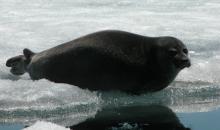Environmental Science and Technology
News
16 Dec 2020
Researchers of Ehime University and the University of Helsinki measured hepatic organohalogen (OHC) concentrations and gene expression profiles in Atlantic salmon collected from three areas in the Baltic Sea. The results showed that OHCs and gene expression profiles were individually grouped in three areas and the covariation of the two datasets provided by a multivariate method was significantly similar. This suggests that the gene expression profiles in salmon are affected by OHC contamination.
14 Sep 2020
This study selected the Japanese macaque (Macaca fuscata) as a model animal for the fetal transfer of OH-PCBs in humans, and revealed OH-PCB concentrations and their relationships in the maternal and fetal brains. The key finding from this study is that OH-PCBs can reach the developing brain of the fetus as early as the first trimester of pregnancy. These OH-PCBs may exceed the levels that induce adverse effects on neurodevelopment.
20 Jul 2020
Environmental pollutants threaten the health of marine mammals. This study established a novel cell-based assay using the fibroblasts of a finless porpoise stranded along the coast of the Seto Inland Sea, Japan, to better understand the cytotoxicity and the impacts of environmental pollutants on the porpoise population. The results revealed that the concentrations of PCBs and DDTs which accumulated in the porpoise are likely to have an adverse effect at the cellular level.
03 Jun 2020
The present study screened known and unknown organohalogen compounds present in mussel and sediment samples from Hiroshima Bay. The results provided scientific evidence that unknown mixed halogenated compounds are ubiquitous in the coastal environment and possess bioaccumulative potential as high as persistent organic pollutants.
15 Apr 2019
The composition of mixed brominated/chlorinated dibenzofurans (PXDFs) and diphenyl ethers in soils from an e-waste site in Ghana suggests a formation of PXDFs through condensation of the flame retardant PBDEs and subsequent bromine-to-chlorine exchange. PXDFs were substantial contributors of toxic equivalents among dioxins from e-waste burning.
29 Mar 2019
New research found that some man-made chemicals bind more easily to a key protein receptor in Russia's Baikal seals than it does in humans, in part because of the physical structure of the chemical.
27 Nov 2018
An inexpensive hydrogel-based material efficiently captures moisture even from low-humidity air and then releases it on demand.
24 Jan 2018
Detailed sorting of scrap car parts could boost recycling rates to over 97%, saving billions spent on new materials and slashing associated greenhouse gas emissions.
08 May 2014
Highlights of Prof. Hayakawa's research who is currently developing methods to identify metabolites of PAHs and NPAHs in urine and blood. Other work include developing the most sensitive method for measuring PAHs and NPAHs, showing that motorcycle engines released more particulate matter than automobiles and more

02 Aug 2005
Rice grown in the United States contains an average of 1.4-5 times more arsenic than rice from Europe, India and Bangladesh.
Events
Sorry, no events coming up for this topic.
Researchers
Sorry, no researchers coming up for this topic.
Giants in history
Sorry, no researchers coming up for this topic.











